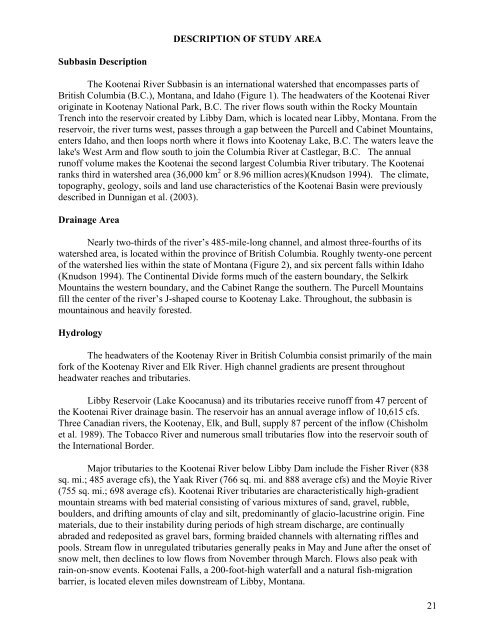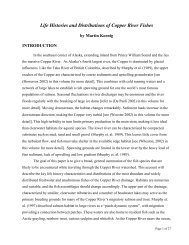Mitigation for the Construction and Operation of Libby Dam
Mitigation for the Construction and Operation of Libby Dam
Mitigation for the Construction and Operation of Libby Dam
Create successful ePaper yourself
Turn your PDF publications into a flip-book with our unique Google optimized e-Paper software.
DESCRIPTION OF STUDY AREA<br />
Subbasin Description<br />
The Kootenai River Subbasin is an international watershed that encompasses parts <strong>of</strong><br />
British Columbia (B.C.), Montana, <strong>and</strong> Idaho (Figure 1). The headwaters <strong>of</strong> <strong>the</strong> Kootenai River<br />
originate in Kootenay National Park, B.C. The river flows south within <strong>the</strong> Rocky Mountain<br />
Trench into <strong>the</strong> reservoir created by <strong>Libby</strong> <strong>Dam</strong>, which is located near <strong>Libby</strong>, Montana. From <strong>the</strong><br />
reservoir, <strong>the</strong> river turns west, passes through a gap between <strong>the</strong> Purcell <strong>and</strong> Cabinet Mountains,<br />
enters Idaho, <strong>and</strong> <strong>the</strong>n loops north where it flows into Kootenay Lake, B.C. The waters leave <strong>the</strong><br />
lake's West Arm <strong>and</strong> flow south to join <strong>the</strong> Columbia River at Castlegar, B.C. The annual<br />
run<strong>of</strong>f volume makes <strong>the</strong> Kootenai <strong>the</strong> second largest Columbia River tributary. The Kootenai<br />
ranks third in watershed area (36,000 km 2 or 8.96 million acres)(Knudson 1994). The climate,<br />
topography, geology, soils <strong>and</strong> l<strong>and</strong> use characteristics <strong>of</strong> <strong>the</strong> Kootenai Basin were previously<br />
described in Dunnigan et al. (2003).<br />
Drainage Area<br />
Nearly two-thirds <strong>of</strong> <strong>the</strong> river’s 485-mile-long channel, <strong>and</strong> almost three-fourths <strong>of</strong> its<br />
watershed area, is located within <strong>the</strong> province <strong>of</strong> British Columbia. Roughly twenty-one percent<br />
<strong>of</strong> <strong>the</strong> watershed lies within <strong>the</strong> state <strong>of</strong> Montana (Figure 2), <strong>and</strong> six percent falls within Idaho<br />
(Knudson 1994). The Continental Divide <strong>for</strong>ms much <strong>of</strong> <strong>the</strong> eastern boundary, <strong>the</strong> Selkirk<br />
Mountains <strong>the</strong> western boundary, <strong>and</strong> <strong>the</strong> Cabinet Range <strong>the</strong> sou<strong>the</strong>rn. The Purcell Mountains<br />
fill <strong>the</strong> center <strong>of</strong> <strong>the</strong> river’s J-shaped course to Kootenay Lake. Throughout, <strong>the</strong> subbasin is<br />
mountainous <strong>and</strong> heavily <strong>for</strong>ested.<br />
Hydrology<br />
The headwaters <strong>of</strong> <strong>the</strong> Kootenay River in British Columbia consist primarily <strong>of</strong> <strong>the</strong> main<br />
<strong>for</strong>k <strong>of</strong> <strong>the</strong> Kootenay River <strong>and</strong> Elk River. High channel gradients are present throughout<br />
headwater reaches <strong>and</strong> tributaries.<br />
<strong>Libby</strong> Reservoir (Lake Koocanusa) <strong>and</strong> its tributaries receive run<strong>of</strong>f from 47 percent <strong>of</strong><br />
<strong>the</strong> Kootenai River drainage basin. The reservoir has an annual average inflow <strong>of</strong> 10,615 cfs.<br />
Three Canadian rivers, <strong>the</strong> Kootenay, Elk, <strong>and</strong> Bull, supply 87 percent <strong>of</strong> <strong>the</strong> inflow (Chisholm<br />
et al. 1989). The Tobacco River <strong>and</strong> numerous small tributaries flow into <strong>the</strong> reservoir south <strong>of</strong><br />
<strong>the</strong> International Border.<br />
Major tributaries to <strong>the</strong> Kootenai River below <strong>Libby</strong> <strong>Dam</strong> include <strong>the</strong> Fisher River (838<br />
sq. mi.; 485 average cfs), <strong>the</strong> Yaak River (766 sq. mi. <strong>and</strong> 888 average cfs) <strong>and</strong> <strong>the</strong> Moyie River<br />
(755 sq. mi.; 698 average cfs). Kootenai River tributaries are characteristically high-gradient<br />
mountain streams with bed material consisting <strong>of</strong> various mixtures <strong>of</strong> s<strong>and</strong>, gravel, rubble,<br />
boulders, <strong>and</strong> drifting amounts <strong>of</strong> clay <strong>and</strong> silt, predominantly <strong>of</strong> glacio-lacustrine origin. Fine<br />
materials, due to <strong>the</strong>ir instability during periods <strong>of</strong> high stream discharge, are continually<br />
abraded <strong>and</strong> redeposited as gravel bars, <strong>for</strong>ming braided channels with alternating riffles <strong>and</strong><br />
pools. Stream flow in unregulated tributaries generally peaks in May <strong>and</strong> June after <strong>the</strong> onset <strong>of</strong><br />
snow melt, <strong>the</strong>n declines to low flows from November through March. Flows also peak with<br />
rain-on-snow events. Kootenai Falls, a 200-foot-high waterfall <strong>and</strong> a natural fish-migration<br />
barrier, is located eleven miles downstream <strong>of</strong> <strong>Libby</strong>, Montana.<br />
21
















